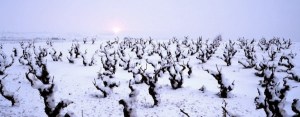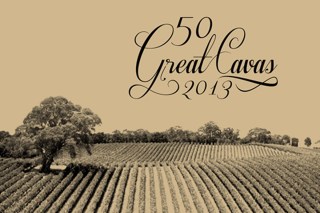
Dormant grape vines in the Catalunyan countryside in the home of one of the world’s most fascinating sparkling wines, CAVA!
Bubbles always get me thinking.
The flavors one can find in a bottle of sparkling wine are inspiring. For centuries, winemakers have been playing with recipes for infusing carbon dioxide gas into a flavor-packed, alcoholic beverage. The ones who have succeeded have been rewarded with the praise of consumers and critics around the globe.
Today, Spanish Cava stands at a crossroads as one of the least-understood and most-enjoyed sparkling wines in the world. Even if the image of Cava has endured a very public, almost pubescent awkwardness, it is impossible not to forecast the beauty emerging from the fizz.
What Is Cava?

Prior to a recent trip to Spain to discover the best of the 50 Great Cavas, I ‘surveyed’ consumers and friends, family and colleagues to gauge Cava’s international image. Many, I am sad to say, had no idea what I was talking about – they were mostly beer drinkers. Some #winelovers were able to compare Cava to other sparkling wines, but they were unclear on the specifics – where Cava comes from, how it is made, or how it tastes.
My sommelier and wine-geek friends are excited about the “new Cavas” trickling into the international market, but they are a different breed. They live for wine. It’s like oxygen for them.
What my ‘survey’ ultimately revealed is that Cava is misunderstood. Its story – though intricate – is still very much being written. This, of course, has its advantages and its disadvantages. The fact of the matter remains. Most consumers don’t know what the hell Cava is.
At its most basic level, Cava is a sparkling wine, made in Spain, using the classical method for infusing wine with carbon-dioxide gas. When the wine bottle is opened, the trapped gas is released and bubbles make it appear as though the wine is sparkling.
When the wine is poured into a glass, the gas releases complex aromas of fruit, confections, spices, pastries, and other delights. It is one of the most intriguing aspects of any sparkling wine – the aromatized flavor precursors – a snapshot of what you are about to taste.
How Is Cava Made?
Cava is made using a two-fold method. First, grapes are harvested and pressed to release a sweet juice that is fermented into a simple tasting basic wine. This basic wine isn’t all that impressive in this moment. The magic of sparkling wine is when the basic wine is bottled with additional sugar and yeast — called liquer di tirage — and the bottle is sealed with either a cork or a cap.
A second fermentation takes place inside the bottle. This process creates carbon-dioxide gas which gets absorbed into the wine. The bottle fermentation process does not take long, but it is what happens after the bottle fermentation is complete which adds character to the Cava.
Autolysis & Aging
As the wine rests inside the bottle with the yeast/sugar sediment — called lees — an interesting exchange of flavor takes place. Not only has the wine absorbed carbon dioxide gas and risen one degree of alcohol (or more) as a result of the second fermentation, the wine takes on some of the aromas and flavors of the lees inside the bottle.
Lees aging can impart nutty, buttery, biscuity flavors – but the general consensus is that the basic wine that went into the bottle has gained a measurable amount of complexity. The process is called autolysis. Autolysis is an enzymatic breakdown of yeast cells and the resulting absorption of those flavors into the wine as the wine rests on the yeast lees. The longer the Cava ages on lees, in the bottle, the more complex it potentially becomes.
Legally, Cava must be aged in bottle, on lees, in a single wine cellar, for a minimum of 9 months. Most producers have multiple programs and products that feature varied extended aging schemes. Reserva Cava is required to age on lees for a minimum of 15 months. Gran Reserva Cava is to be aged for a minimum of 30 months on lees.
Every wine is subjected to tasting and analysis, prior to labeling, to confirm the standards of El CavaRegulatory Board.
Eventually, the Cava must be disgorged (opened to release sediment from the second fermentation) before it receives a cork and is packaged for sale. Disgorging a bottle fermented Cava is a complex process.

From left to right: Bottles of Cava aging in the cellar; a gyro pallet; the lees of bottle fermentation in the neck after riddling; a legal Cava cork.
Riddling
Disgorgement begins with riddling. Riddling is the method by which the lees is shifted from the bottom or side of the bottle toward the cap. This is done by slowly inverting the bottle so that the lees moves toward the cap/closure by gravity. Though Cava was traditionally riddled by hand — a dangerous job, because of the potential for exploding bottles — most Cava is riddled by machine and gyro pallet today (see pic above).
Once the lees is collected in the bottle neck, the neck is frozen and the lees forms a plug which is pushed out of the bottle when the cap is released. This release of the lees is called disgorgement.
The Cava is systematically topped up with wine that has been captured from other bottles of the same wine. Along with the topping wine, there is usually a dosage, or liquer d’expedition, added. This dosage is usually a secret blend of elements from the winery’s cellar stock. The dosage gives the Cava an additional amount of sweetness and a “house style.”
Styles of Cava
There are many styles of Cava. The most prevalent styles include Brut Nature, Brut, Reserva, Grand Reserva, and Rosat. All styles can be made using white and red grapes. The Rosat category is typically a pale red color because it is made from black/red grapes which are gently pressed prior to fermentation. While Brut Nature is the driest style, the others typically have some dosage — liquer d’expedition — added to soften the flavors of the Cava.
While all Cava has a minimum bottle aging – sur lees – of nine months, most producers will age their wines longer than the minimums. In bottle, lees aging contributes myriad flavors to Cava. Even the most basic Cava can benefit from extended lees aging.
Sweetness levels vary too. Cava can be labelled in the following ways, based on the level of sugar (in grams per liter – g/L) in the final wine, at disgorgement and recorking: “Brut Nature” can have up to 3 g/L (but no sugar can be added in the dosage); “Extra Brut” can have up to 6 g/L; “Brut” can have up to 12 g/L; “Extra Dry” can have 12–17 g/L of sugar; while “Dry” stryles usually have somewhere between 17 and 32 /L. Dry is actually quite sweet! The sweetest styles of Cava are “Semi Dry” with 32–50 g/L and “Sweet” with over 50 g/L of sugar.
Got it?

Left to right: A vineyard in Catalunya; Cava grapes: Paralleda, Xarel-lo, Macabeo; the manual disgorging process; fresh baccala with tomatoes
The Grapes
While Chardonnay and Pinot Noir have proven to make some of the best sparkling wines in the world, Cava producers in Spain have discovered that their native Paralleda, Xarel-lo, and Macabeo grapes produce delicious high quality wines with a local and international appeal.
Macabeo provides essential acidity to the Cava, while Xarel-lo tends to add fruity aromas and acidity. Parellada adds a softness and floral character to Cava. Malvasia can also be used. Some producers also like using Chardonnay for structure and body, and Pinot Noir for additional aromatics and some color. The grape varieties Trapet, Pinor Noir, Garnacha, and Monastrell are used to make Rosat (rosé) Cava, but Macabeo, Xarel-lo, and Parellada are the primary grapes used in a majority of the wines.
Where Cava is Made
While Cava can be made in over 150 communities in eight wine regions around Spain, the focal point of production is in the region of Penedes, along the Anoia River valley and in the hills outside of Sant Sadurni d’Anoia, northwest of Barcelona.
Other areas where Cava can be made include Aragon; the Basque Country; Castille y Leon, Catalonia; Extremadura; Navarra; Rioja; and Valencia.
Availability
While hundreds of millions of bottles of Cava are made every year, a lot of Cava is consumed in Spain. That being said, in 2012, about 240 million bottles were sold, over half of which were exported. So, it’s not like Cava is hiding. It has quietly been garnering attention and praise from consumers and critics alike.
The trick is finding the high quality Cava that will make you reconsider buying other sparkling wines.
Until now, the big Cava houses – Freixenet and Codorníu, who have cornered about 75% of the Cava market – have been able to produce enough cheap Cava to satisfy and maintain an off-premise bottle price around $10. These wines have introduced Cava to the international wine trade, but they have done little if anything – while cornering the market – to create intrigue or curiosity in the greater possibilities of what Cava can be.

Left to right: A cathedral and barrels at Caves Bohigas; Cava capsules; wine tanks at a “wine cathedral”
Food & Cava
Like most wines, Cava tastes best with the fare of the territory. This means Catalunyan cuisine. Catalunyan cuisine is quintessentially Mediterranean in that seafood and inland agriculture often meet in simple dishes with a lot of flavor.
What’s great about Cava is that because it often has a great acidity and either a hint of sweetness or a lees-infused richness, it plays well with nearly any dish you can imagine – from light salads, cheese, salami, stews, fish, sushi, sauteed and roasted meats and vegetables, even popcorn and French Fries. The most important idea is to buy, cook, and eat with fresh ingredients.
The foods I would avoid pairing with Cava include high-acid sauces and marinades, extremely bitter cooking methods and barbecue.
What’s Next?
There is so much momentum behind the multi-billion dollar Cava business that the sheer momentum will be inherited for generations – barring any unforeseen phylloxera-like happenings which wiped out the wine industry in Catalunya in the late 1800s, paving the way for the Cava of today.
But, more on that later …
If you have questions, or you would like to contribute something to this series, please consider using the comments section below, and/or send us an eMail.
Pingback: Wine and Dine As One | Study Abroad 2017